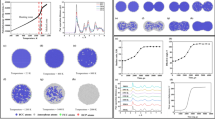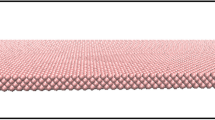Abstract
A problem of compacting a mixture of copper and molybdenum nanopowders under the action of external loading generated by a spherical piston is solved by the molecular dynamics method. Interatomic interaction is calculated with the use of a multiparticle potential obtained by the embedded atom method. It is shown that compaction leads to significant deformations in copper, resulting in the loss of the crystalline structure; copper nanoparticles melt and fill the entire porous space. Molybdenum particles are deformed to a much smaller extent; they are not destroyed and preserve their crystalline structure. Under high loading, there appear voids in copper at the stage of compact extension; these voids rapidly grow in size and coagulate into one large void located in the nanocell center.
Similar content being viewed by others
References
A. B. Sawaoka (ed.), Shock Waves in Materials Science, Springer-Verlag, Hong Kong-Barcelona-Budapest (1993).
R. Prummer, Explosivverdichtung Pulvriger Substanzen, Springer-Verlag, BRD (1987).
V. V. Ivanov, Yu. A. Kotov, A. N. Vikhrev, and N. I. Noskova, “Hot dynamic compaction of nanosize powders of aluminum and titanium oxides,” Dokl. Ross. Akad. Nauk, 352, No. 6, 759–761 (1997).
S. P. Kiselev and V. P. Kiselev, “Compaction of copper nanopowder in a shock wave,” Fiz. Mezomekh., 9, No. 6, 59–70 (2006).
S. P. Kiselev, “Compaction of copper nanopowder,” J. Appl. Mech. Tech. Phys., 48, No. 3, 412–419 (2007).
G. A. Shvetsov, V. I. Maly, A. G. Anisimov, et al., “High-current ARC erosion of explosively compacted Mo/Cu and W/Cu electrodes,” IEEE Trans. Magn., 33, No. 1, 410–412 (1997).
V. I. Mali and T. S. Teslenko, “Structure and properties of explosively compacted copper-molybdenum,” Combust., Expl., Shock Waves, 38, No. 4, 473–477 (2002).
M. P. Allen and D. J. Tildesley, Computer Simulation of Liquids, University Press, Oxford (1987).
F. Cleri and V. Rosato, “Tight-binding potentials for transitions metals and alloys,” Phys. Rev. B, 48, 22(1993).
M. A. Karolewski, “Tight-binding potentials for sputtering simulations with FCC and BCC metals,” Radiat. Effects Defects Solids, 153, 229–235 (2001).
M. Yan, V. Vitek, and S. P. Chen, “Many-body central force potentials and properties of grain boundaries in NiAl,” Acta Mater., 44, 4351–4365 (1996).
A. V. Bolesta, “Modeling of processes at internal boundaries in metallic nanostructures,” Candidate’s Dissertation in Phys.-Math. Sci., Novosibirsk (2002).
J. Belak, “On the nucleation and growth of voids at high strain-rates,” J. Comput. Aided Mater. Design, 5, 193–206 (1998).
Author information
Authors and Affiliations
Corresponding author
Additional information
__________
Translated from Prikladnaya Mekhanika i Tekhnicheskaya Fizika, Vol. 49, No. 5, pp. 11–23, September–October, 2008.
Rights and permissions
About this article
Cite this article
Kiselev, S.P. Compaction of a mixture of copper and molybdenum nanopowders modeled by the molecular dynamics method. J Appl Mech Tech Phy 49, 712–722 (2008). https://doi.org/10.1007/s10808-008-0089-0
Received:
Published:
Issue Date:
DOI: https://doi.org/10.1007/s10808-008-0089-0




